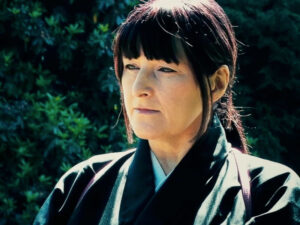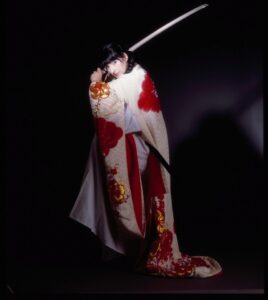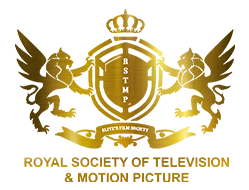
Lady Samurai – the final cut | Interview
RSTMP: What inspired you to create a film about the benefits of martial arts and music, and how did you come up with the concept for Lady Samurai?
Fay: In the tapestry of my existence, intertwined with the threads of resilience and grace, two pillars have stood steadfast: the harmonies of music and the dance of martial arts. In the depths of life’s trials, they have been my guiding lights, illuminating my path with their ethereal glow.

From tender beginnings, a celestial bond was forged between me and the realm of melodies. At the tender age of six, an upright piano found its way into my realm, a precious gift bestowed by my father’s hands. A vessel of enchantment, it whispered secrets to my eager soul, igniting the flames of composition within. Notes unfurled like delicate petals, painting portraits of emotions on the canvas of my heart.
Yet fate had more in store for me, an unexpected twist in the grand symphony of my journey. It arrived in the form of my younger brother, captivated by the legendary Bruce Lee, his spirit ignited by the flames of martial prowess. And oh, how he practiced his newfound skills upon me, his sister, like a mischievous muse. Each day unfolded like a Pink Panther episode, filled with laughter and playful sparring.
In the wake of these spirited encounters, a calling beckoned me to explore the realm of martial arts, to step onto the sacred mat and embrace the discipline it offered. And so, I embarked on a transformative odyssey, where courage blossomed, and confidence bloomed. The art of combat became a guardian, empowering me to safeguard my being and embark upon solitary voyages across distant lands, imparting wisdom to those yearning for light as I shared my challenging journey.
The convergence of martial arts and music birthed a symphony of healing within me, a symphony that resonated with the universe’s heartbeat. Through the darkest hours, I discovered the power to not only survive but to mend the fragmented souls that crossed my path. A dance of swords and melodies, intertwining their essence, became my anthem of resilience.
And then, amidst the tapestry of my existence, a serendipitous encounter occurred, like a celestial alignment choreographed by destiny itself. Bey Logan, the maestro of the martial arts magazine COMBAT, witnessed a captivating spectacle of my live performance with the ancient Koto blade, a relic from the fifteenth century. His words, like gentle rain on parched soil, touched the depths of my being. I felt truly humbled.
“Lady Samurai,” he declared, in his feature article. And so, my essence was christened, embraced by all who beheld my spirit. It became my new moniker, a whimsical reflection that sparked laughter in the heart of my dear brother, Clive.
Thus, the narrative of my life continues to unfold, a dance of resilience, harmonised with the cadence of music and the elegance of martial arts. With each step and every melodious note, I transcend the boundaries of self, inviting others to find solace in the symphony of their own existence.
RSTMP: Lady Samurai features a unique mix of traditional Japanese culture and modern-day issues. How did you balance these elements in the film?
Fay: Lady Samurai, a tapestry woven with the essence of traditional Japanese culture and the intricate threads of modern-day concerns. How did I balance these elements in the film? Ah, a question that leads me through the corridors of reflection, where memories dance like Sakura petals in the breeze.
Enveloped in the enchantment of Japanese and Korean allure, I found myself immersed in their splendid traditions, their art forms, and their profound wisdom. The roots of my fascination with martial arts sank deep into the soil of their origins, absorbing the essence of history and philosophy. Yet, my love for music, an eternal muse, beckoned me to explore the vibrant tapestry of Japan’s contemporary pop culture. Oh, the harmonious energy that transcends through the intertwining realms of music and martial arts.
The delicate balancing act unfolded as a symphony of grace, harmonising the ancient melodies of tradition with the resonating chords of present-day concerns. Each brushstroke on the canvas of the film was imbued with intention, crafting a narrative that celebrated the beauty of heritage while shedding light on the struggles faced by modern society. It was an exploration of dichotomies, a dance between reverence and innovation, tradition, and progression.

And then, the journey unfolded, propelled by the ebb and flow of life’s currents, navigating the labyrinth of challenges that lay in wait. Filming Lady Samurai was an odyssey fraught with obstacles, a test of resilience and unwavering determination. The most daunting of these trials was the pervasive belief that such an accolade, the pinnacle of martial arts mastery, was unattainable for a woman, especially one hailing from foreign shores. Yet, with an unwavering spirit, I allowed destiny’s hand to guide me along the path, trusting in the innate wisdom of the universe.
As the camera captured my footsteps upon this formidable path, the challenges and obstacles unfolded naturally, mirroring the journey towards a seemingly unattainable destination. The documentary became a testament to the human spirit’s unwavering resolve, defying expectations, and surpassing limitations. It was a testament to the power of unity, as my production team, my beloved family, my devoted martial arts students, and my revered Japanese teachers rallied beside me. In particular, my main teacher, the indomitable Haruna Sensei, became a beacon of guidance and strength, propelling me forward with his unwavering belief in my abilities.
The vision of Lady Samurai materialized as a delicate dance between tradition and contemporary themes, a homage to the profound roots from which I drew inspiration, and a celebration of the ever-evolving spirit that infuses the present moment. It is a testament to the timeless allure of Japanese and Korean culture, forever captivating and guiding my journey.
RSTMP: What was the most challenging part of filming Lady Samurai, and how did you overcome those challenges?
Fay: As I pursue my passion for martial arts, events in the documentary unfurl naturally, reflecting the twists and turns of my journey towards a seemingly unattainable goal. This path, paved with challenges and obstacles, is one that many would deem impossible for a woman, let alone one from outside of Japan. Nevertheless, I let everything unfold organically, trusting in the flow of life to guide me towards my destiny.
Japanese and Korean culture have always held a mysterious allure for me. From the elegant simplicity of their traditional dress to the intricate beauty of their ancient practices, I am captivated by their every detail. My love for martial arts stems from this fascination and a deep appreciation for its origins. Yet, while I am drawn to the rich tapestry of Japan’s past, I am equally enamoured by its modernity and dynamism. I strive to marry traditional forms with contemporary pop culture in my music, creating a unique blend that reflects both my heritage and my passion for innovation.

As I journey through the documentary, my path unfolds organically, revealing the unexpected twists and turns that arise as I strive for the highest honour possible: acceptance into the inner sanctum of Japanese traditional practice and holy places. I just wanted to be accepted by my western culture to. Despite the obstacles placed before me by western prejudices, I refuse to be deterred. With the unwavering support of my production team, my family, my martial arts students, and my Japanese teachers – particularly my main teacher, Haruna Sensei – I am able to push past the boundaries and gain access to the world beyond. It is a testament to the power of determination and the strength of the human spirit we all possess.
RSTMP: What do you hope viewers take away from Lady Samurai, both in terms of the film’s message and its representation of Japanese culture?
Fay: My story is one of perseverance and hope. I want viewers to be inspired by the message that no matter how daunting the challenge, we must never give up on our dreams. Life is full of disappointments, setbacks, and heartbreak, but we must transcend the boundaries placed in our path and follow our hearts, always speaking our truth. We must approach each obstacle with the innocence of a child, believing in the innate goodness of humanity even in the face of adversity. We must never let our hearts be broken, but instead remain steadfast in our pursuit of the truth. Only then can we influence the world for the greater good, united in our kindness and compassion.

RSTMP: Can you talk about your creative process for making the film, from initial concept to final product?
Fay: Music and martial arts are two worlds that, on the surface, may seem vastly different. Yet, in my experience, they share a common thread: the power of energy, the unbreakable bond between mind, body, and spirit. In my work, I strive to meld the two together, allowing the beauty and power of each to shine through. Whether I am composing a piece of music that sings from the heart with Japanese textures or practicing Iaido, I am striving to bring my music and martial arts together as one. It is through this journey, rising to the challenge and embracing both the good and the difficult, that I am able to truly transcend the boundaries of what is possible.
RSTMP: Lady Samurai features some beautiful cinematography and music. Can you talk about how you worked with your team to achieve those aspects of the film?
Fay: My team is made up of people who share my love of music and martial arts philosophy. Together, we are inspired by the majesty of nature and the limitless potential of energy in all its forms. Whether we are admiring the gentle sway of a flower in the fields around a temple in Japan or crafting a piece of music that resonates with the soul, we seek to tap into the universal flow of energy that surrounds us. For us, music is the voice of the soul, capable of healing and uplifting us in ways that few other things can.


